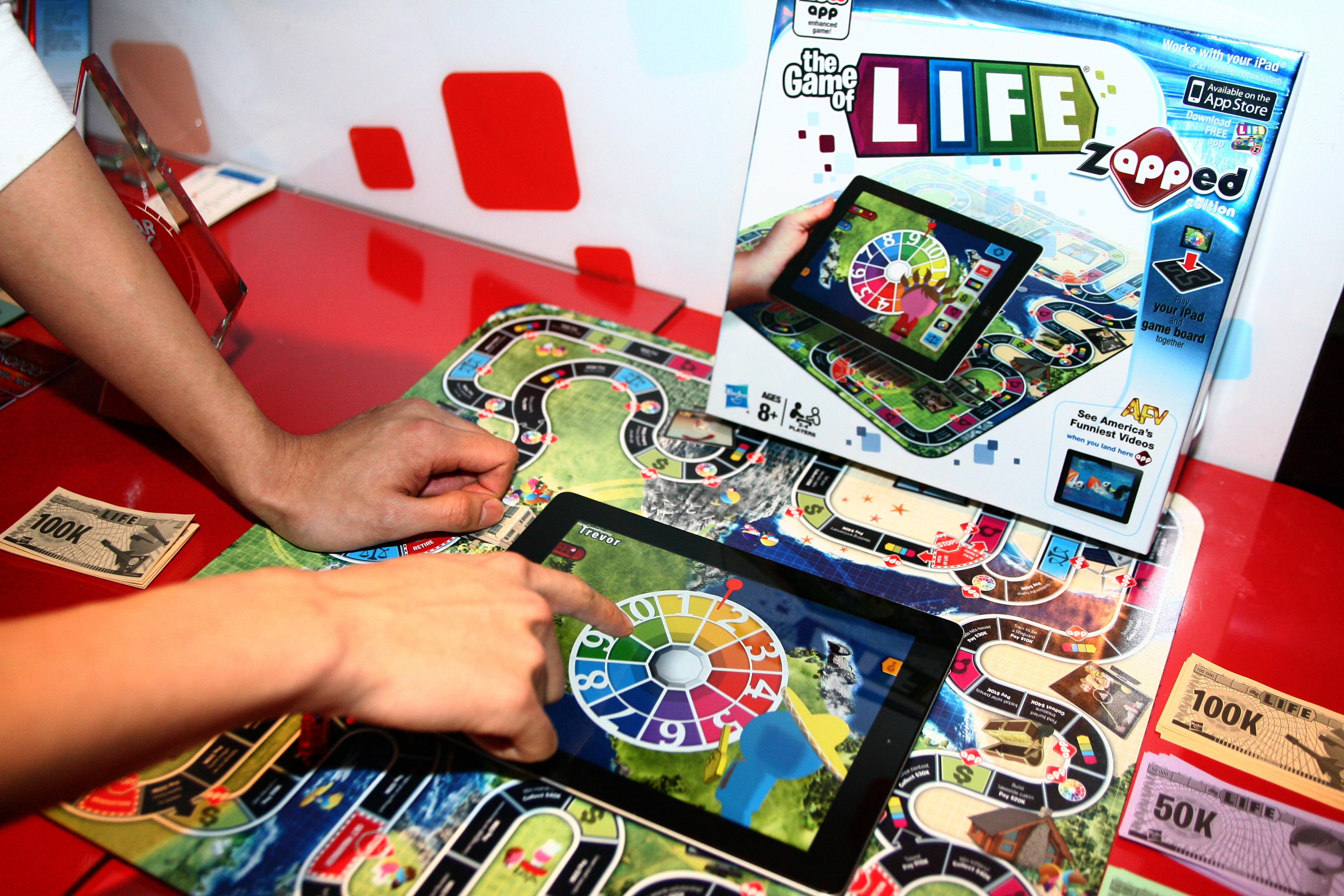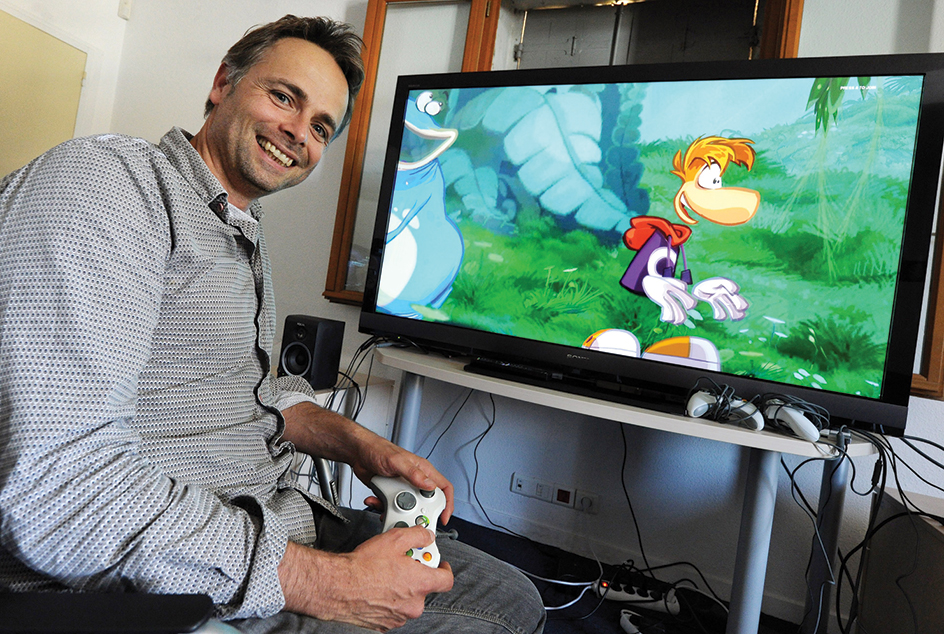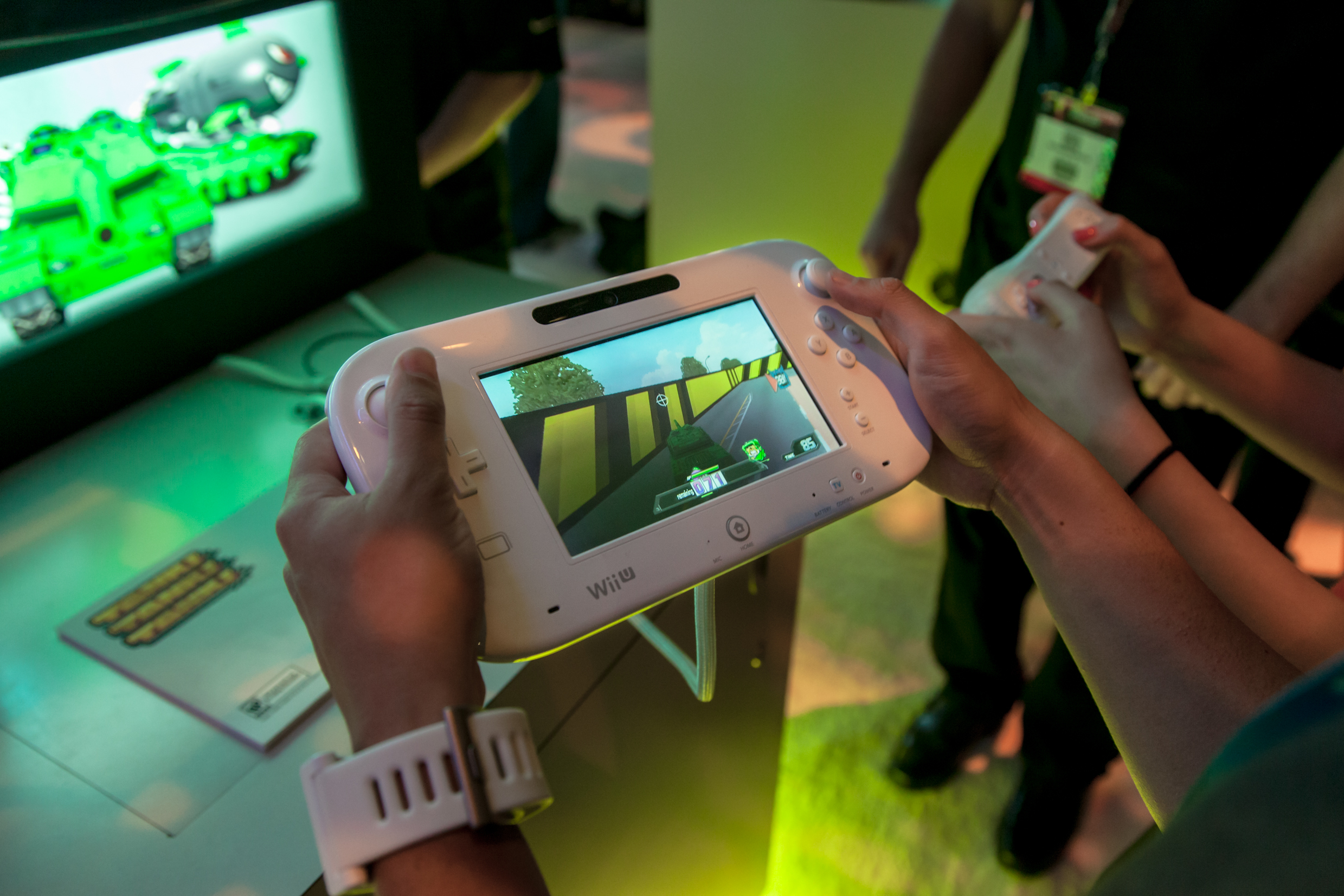Electronic game is a game played using a computer and a video display. Such games, including video games and computer games, have become one of the most popular forms of entertainment. When electronic games were first widely introduced, most people considered them novelties or children’s toys. Today, statistics indicate that the average electronic game player is an adult. As players have matured, games have grown in sophistication and diversity. Many scholars now consider electronic games to be a significant form of cultural expression, much like popular music, television, or motion pictures.

An electronic game is essentially a computer program designed to entertain. It may run on a personal computer, a coin-operated arcade machine, a cellular telephone, or another computerized device. Many games are played on video game consoles, household computers built specifically for gaming. Most of the action in an electronic game takes place on the video display. Players operate the game using input devices called controllers.

Some of the earliest electronic games took traditional games, such as tennis, and re-created them in a computerized form. Even today, simple electronic versions of traditional card and board games remain popular. More sophisticated games simulate some extraordinary experience—such as battling monsters or flying combat aircraft—in varying levels of detail and realism. The most advanced games let the player explore and participate in vast artificial worlds. These games can be intense sensory experiences that borrow heavily from film, television, music, fashion, and even architecture.
Electronic games differ from other media in that games are highly interactive—that is, the player takes part in and helps guide the action. An electronic game offers players certain choices. As in a traditional game, a set of rules limits these choices and helps determine their consequences. In an electronic game, the rules are contained in lines of computer code. Rather than telling players the outcome of their choices, the computer expresses the results through the sights and sounds of the game. The players’ choices and the computer’s responses combine to create an experience called gameplay.
This article will discuss how game designers create electronic games, the various devices on which games can be played, and the history of electronic games. It will also discuss concerns about the effects of games on players and their use in education.
Game design
Early electronic games were created by one person or a small group of people. More complex modern games require large development teams. Such a team may consist of 20 to more than 120 people working in various roles. Producers manage the overall development of the game, coordinating the activities of the other team members. Game designers create the rules that will govern gameplay. Gameplay is so important to a game’s success that some top game designers have become widely known gaming celebrities. One or more level designers may lay out the various areas or levels of the game. Artists and sound engineers develop the look and sound of the game. Programmers work to incorporate all these elements into the game’s computer code. Playtesters test the game by playing it at various stages during development.
The design of an electronic game includes three major elements. They are: (1) graphics, (2) sound, and (3) gameplay.

Graphics
are the game’s visual elements. The graphics of a simple puzzle game might consist of a few basic shapes moving over a plain backdrop. More sophisticated graphics can look nearly as realistic as photographs. Artists design some games to look as realistic as possible. Other games use stylized graphics to create a particular mood, imitating comic books, cartoons, or even fine art.

Graphics can be two-dimensional or three-dimensional. Two-dimensional graphics are flat. Three-dimensional graphics have depth.
To create two-dimensional graphics, the artist begins with a flat image that serves as a backdrop. The artist overlays the backdrop with smaller images called sprites. A sprite may represent a character, a weapon, or some other element in the game. Much like a paper cutout, a sprite can move around over the backdrop. Artists often animate sprites to make them appear less rigid. They create a series of flat images that, when flashed in rapid succession, give the illusion of motion. Carefully drawn and animated sprites can even provide the illusion of depth.
True three-dimensional graphics, by contrast, consist of computer models that resemble virtual sculptures. The models have no color, texture, or shading. Artists add these qualities by “painting” two-dimensional images onto the models. They animate the models by manipulating their parts, much as a puppeteer moves the parts of a puppet. In a completely three-dimensional game, every object is a model, and each level is like a computerized dollhouse filled with such models.
Most games combine two-dimensional and three-dimensional graphics. For example, even primarily three-dimensional games often use animated sprites to show certain effects, such as explosions.
Sound
in an electronic game is generally broken into pieces, so that different sounds can accompany different events in the game. Sound designers choose pre-recorded sounds from libraries or create their own sound effects.

Many games feature a musical score that plays in the background, much like the score in a motion picture. The music may change according to the action of the game. For example, the game may play a suspenseful theme when a dangerous event is about to occur.
Game developers recognize that sound can greatly enhance a game’s mood and atmosphere. For this reason, modern games often feature voices recorded by popular actors and scores written and performed by professional musicians.
In some games, sound forms a critical element of gameplay. Such a game might require players to master a musical instrument or to time their actions to music.
Gameplay
is the experience of playing the game. It includes the action of the game along with the interpretation of the action by the player’s imagination. Games often accommodate multiple players, adding a social element to gameplay.
In many games, the player takes on the role of a character in a story. The game may provide the character with goals, or the player may be free to determine the character’s wishes. The rules of the game—including limits on the character’s time, energy, resources, and abilities—combine with the goals to create challenges.
In an electronic game, the display screen acts much like a video camera, following the action from a particular point of view. The way this “camera” covers the action strongly affects gameplay. In fact, people often classify games according to the relationship between the camera and the character the player controls. In a first-person game, the player’s character acts as the camera. The player sees everything just as the character would see it. In a third-person game, the camera shows the player’s character, typically following the character or periodically changing angle to keep the character on screen. Strategy games often show the game landscape from above, much like a map or game board. Many games give the player some control over the camera.
The use of controllers forms a critical aspect of gameplay. A computer mouse and keyboard typically serve as controllers for computer games. Video game consoles use specially designed controllers that can incorporate over a dozen buttons and multiple leverlike controls called joysticks. Some controllers use special sensors to detect the player’s motions. This capability enables the player to interact with the game through movements and gestures. Certain games require unique controllers. Some shooting games, for example, use gunlike controllers, and some music-themed games have controllers that resemble musical instruments.

Gaming platforms
Each electronic game can only be played on a specific type of computer, called a platform. The most popular gaming platforms include: (1) video game consoles, (2) personal computers, and (3) handheld game systems. Developers often release multiple versions of the same game for play on different platforms.
Video game consoles
often come with at least one controller but must be connected to a separate display device, usually a television. Each model of console can only play certain games, but many games come in multiple versions for different consoles. Early consoles commonly played games stored on special cartridges or cards. Later, consoles began using CD-ROM’s, DVD-ROM’s, and other optical discs, discs that are read using lasers. Some consoles can download games over specialized computer networks. Many consoles include some nongaming capabilities, such as playing movies or browsing the Internet.

Consoles are popular with gaming enthusiasts for many reasons. Unlike personal computers, which frequently require special upgrades to run games, consoles generally come with everything needed to begin playing. In addition, console games rarely crash (stop working) because the games are tailored to run smoothly on a specific machine. Modern consoles enable gaming enthusiasts to play together over computer networks, a capability once limited to personal computers.
Console manufacturers generally release newer, more powerful models about every five years. Game developers often continue to produce games for a console for about five years after a newer model is introduced. Thus, most consoles remain usable for about 10 years. Some hobbyists collect and play older consoles.
Personal computers
also rank as popular gaming platforms. Many early computer games came on floppy disks, cartridges, and even cassette tapes. Later, computer game developers began using CD-ROM’s, DVD-ROM’s, and other optical discs or offering games for download over the internet. To play the latest games, computer owners must regularly upgrade their machines, particularly their graphics capabilities. However, some players prefer personal computers to consoles because they can choose from a wider variety of models and accessories, enabling them to customize their gaming experience. Personal computers can also connect to the internet and perform a much wider range of nongaming functions.
The combination of a keyboard and mouse offers players a more sophisticated range of input options than does the average video game controller. As a result, personal computers lend themselves to strategy games, which often require the player to coordinate multiple game elements. Keyboards also enable players to communicate with one another via text, making personal computers a popular choice for gaming over networks.
Personal computers also lend themselves to casual games, games designed to be quick and easy to learn. Casual games—many of them puzzle games or simple action games—appeal to a broader range of players than do more complex games.
Anyone with a computer and the appropriate skills can create a computer game and distribute it over the internet. For this reason, computer game players have access to a wide range of unique, independently developed games.
Handheld game systems
are essentially miniature consoles that players can carry with them. They combine a computer, video display, and controller into a single compact device. Handheld games often come on small cartridges, cards, or even optical discs.
Handheld systems have small screens and less computing power than consoles or personal computers. For this reason, they tend to feature simpler games. Some handheld games are scaled-down versions of popular console games. Other games make up for a lack of complexity with simple, innovative gameplay. Because they can be played almost anywhere, handheld systems remain fairly popular, especially among younger players.
Other platforms
have varied in popularity over the years. In the late 1970’s, for example, players flocked to free-standing arcade machines in public places. Arcade games eventually declined in popularity. However, players continue to enjoy arcade games, especially those that offer unique controllers. A racing arcade game, for example, might feature controls designed to mimic a race car’s steering wheel, pedals, and stickshift.
As computer technology develops, new types of gaming platforms occasionally emerge. In the late 1990’s and early 2000’s, for example, telephone companies began offering games for play on cellular phones.

History
Historians disagree on who invented the electronic game. Many credit the American physicist William Higinbotham. In 1958, he created a game called Tennis for Two using electronic laboratory equipment. The game let players bounce an electronic “ball” back and forth over a “net.” The German-born television engineer Ralph Baer created a similar game that was released in 1972 on the Magnavox Odyssey, the first home video game console. The game was simple, but players enjoyed the novelty of controlling the action on the TV screen.
Early computer games
were created and played on large computer systems at universities and research laboratories. The American computer programmer Steve Russell developed Spacewar! (1961), a game in which two spaceships fight each other. In the 1970’s, the American computer programmer William Crowther developed the first computer game to tell a story. The game, which became known as Colossal Cave Adventure, was a text-based adventure game, a type of computer game played by reading descriptions and entering text commands.

Arcade games.
The American engineer Nolan Bushnell adapted Spacewar! into the first commercially sold arcade game, Computer Space (1971). In 1972, Bushnell released Pong, an arcade game based on table tennis. It launched the first major video game company, Atari.
The arcade game Pac-Man (1980) introduced the first widely popular video game character. Pac-Man inspired several sequels, a popular song, a television show, and various toys and other merchandise.
The rise and fall of Atari.
In 1977, Atari released the Video Computer System (VCS), later known as the Atari 2600. This early console became a huge success. Its most popular games were home versions of such arcade hits as Space Invaders (1978) and Asteroids (1979).
In 1982, Atari released two highly awaited games—E.T. the Extra-Terrestrial and a console version of Pac-Man. Critics judged both games to be of poor quality and accused the company of rushing to get them to market. Millions of copies of the games went unsold, and Atari collapsed. A widely perceived lack of quality in games convinced many people that video gaming was just a passing fad. In 1983, the industry entered a slump that lasted several years.
The Nintendo revolution.
In the mid-1980’s, the Japanese company Nintendo released the Family Computer (Famicom) in Japan, and later released a similar system internationally known as the Nintendo Entertainment System (NES). Nintendo revived the video game industry with the help of its feature game, Super Mario Bros. (1985), developed by the Japanese game designer Shigeru Miyamoto. Super Mario Bros. revolutionized gaming with its bright, friendly colors, original music, and imaginative characters. Unlike Atari, Nintendo became known for its strict quality control standards, and its games won the respect of critics and players alike.
Scholars credit much of Nintendo’s success to the work of Miyamoto and his development team. His ground-breaking fantasy adventure The Legend of Zelda (1986) enabled players to save their progress, connecting multiple game sessions into an epic quest. Zelda and its sequels and the Super Mario Bros. games rank among the most popular video game series ever.
In the late 1980’s, Nintendo released its first Game Boy handheld console. The Game Boy sold well with the help of Tetris (1989), a popular version of a puzzle game created by the Russian mathematician Alexey Pajitnov.
In the early 1990’s, Nintendo continued to dominate the console market with its Super Nintendo Entertainment System (SNES). The SNES game Star Fox (1993) stood out for its innovative three-dimensional graphics. However, the SNES met vigorous competition from Sega’s Genesis console. Sega’s fast-moving Sonic the Hedgehog (1991) and many sports titles drew the attention of older audiences.
Fighting games,
which feature hand-to-hand combat between virtual opponents, peaked in popularity during the early and middle 1990’s. The arcade game Street Fighter II (1991) impressed players with its balanced characters, fine controls, and strategic complexity. Mortal Kombat (1992) shocked parents and politicians with its violent gameplay and gory graphics. In response, the video game industry established the Entertainment Software Rating Board (ESRB). The board rates games by recommending an appropriate age range for players.
The growth of computer gaming
began in the 1980’s with the spread of personal computers, such as the Commodore 64, Apple II, and IBM PC. Compared to console games, computer games generally featured inferior graphics but more mature themes that appealed to adults. Games introduced on computers during the 1980’s included driving and flight simulators and the first role-playing games, which focus on character development and problem-solving rather than fast action.
From the late 1980’s through the 1990’s, improvements in computer technology produced an era of innovation in computer games. The introduction of the CD-ROM, for example, vastly increased the storage capacity of computer games. Myst (1993) used the extra capacity to add lavish graphics and rich music, creating an atmospheric, puzzle-based adventure game. This approach broadened the appeal of games and expanded the diversity of themes available to game designers.
Computers themselves became more powerful, enabling them to handle more three-dimensional graphics. Three-dimensional gameplay became standard through role-playing games, such as Ultima Underworld: The Stygian Abyss (1992), and first-person shooting games, such as Wolfenstein 3D (1992) and Doom (1993).
Increases in computing power led designers to develop more sophisticated strategy and simulation games. The American game designer Sid Meier pioneered such games, including Sid Meier’s Pirates! (1987) and Sid Meier’s Civilization (1991). Civilization was a turn-based strategy game, one that let the player plan the action, which the computer carried out over a period called a turn. Faster paced real-time strategy games—such as Dune II (1992) and Warcraft: Orcs & Humans (1994)—allowed the player to issue commands to vast armies as the action unfolded. The urban planning simulator SimCity (1989), by the American designer Will Wright, spawned a series of popular simulation games.
The growth of computer networks enabled gaming enthusiasts to play first-person shooting games and real-time strategy games with one another over great distances. Such networks also nurtured the spread of multi-user domains (MUD’s). These text-based adventure and role-playing games let thousands of players interact with one another in an imaginary setting.
Renewed interest in consoles.
In the mid-1990’s, the giant electronics manufacturer Sony Corporation entered the console business with the introduction of the PlayStation. The new console took advantage of the large storage capacity of CD-ROM’s, offering games with more graphics and sound than ever before. PlayStation games, such as Resident Evil (1996) and Final Fantasy VII (1997), combined three-dimensional characters, animations, and cinematic camera techniques to produce an almost movielike experience. The PlayStation also boasted a wide range of games and quickly beat out the rival Sega Saturn console.
Despite the limited storage capacity of its cartridges, the Nintendo 64 earned a loyal following for its exceptional graphics and game design. Miyamoto’s team created the Nintendo 64’s controller specifically for use with three-dimensional games. The console also came with Miyamoto’s Super Mario 64 (1996). Critics consider the game one of the finest ever made for the way it reimagined the classic Super Mario Bros. game in the context of three-dimensional play. The Legend of Zelda: Ocarina of Time (1998) won similar praise, combining Super Mario 64’s three-dimensional play with an epic storyline, hundreds of puzzles, and a sweeping musical score.
Competition for older players
heated up in the early 2000’s with the release of Microsoft Corporation’s Xbox console. Rivals included Sony’s PlayStation 2, Nintendo’s GameCube, and Sega’s Dreamcast. With such huge companies as Sony and Microsoft spending billions of dollars on development and promotion, Sega could not compete and soon shut down its console business. Nintendo continued to appeal to younger audiences, while Sony and Microsoft battled for older players.
Three series of games played central roles in the growing adult gaming market. Older sports fans were drawn into video gaming by sports titles from the developer Electronic Arts—particularly the Madden NFL series of pro football games. Critics credit the Grand Theft Auto III series of games with making the PlayStation 2 a dominant console. The games, which put players in the role of urban gangsters, sparked controversy for their violence but captured imaginations with their expansive game worlds and free-form play. Microsoft achieved great success with its Halo series, a first-person shooter game that let players compete in teams over a computer network.
Social gaming.
In the early 2000’s, a wide range of network capabilities continued to make personal computers the platform of choice for social gaming. Will Wright’s The Sims (2000) let players build virtual neighborhoods, guiding the day-to-day lives of their inhabitants. The Sims won many new players with its innovative, nonviolent gameplay. But perhaps more importantly, the game allowed players to create their own content and share it with others over the internet, resulting in an online community of Sims enthusiasts.
The development of massively multiplayer online games (MMO’s) offered even greater opportunity for social gaming. MMO’s are essentially virtual worlds stored on remote computers called servers. Thousands of subscribers can connect to a game at the same time, populating the game’s world with characters. Players can meet up with one another to do battle, complete quests, and even shape the world itself. Such successful massively multi-player online role-playing games (MMORPG’s) as Everquest (1999) and World of Warcraft (2004) helped popularize this format. Fortnite: Battle Royale, another popular MMO, was initially released in late 2017, and soon attracted over 100 million players.
Bigger games.
In 2005, video game developers began introducing a generation of consoles designed to push gaming in new directions. Microsoft’s Xbox 360 and Sony’s PlayStation 3 both featured unprecedented graphics capabilities. Such games as Gears of War (2006) and Bioshock (2007) presented game worlds of remarkable graphical detail and depth.

But visually impressive games proved expensive to produce, and many independent game development companies struggled to survive. Many game developers turned to in-game advertisements to help with the cost of development and promotion. To reduce financial risk, established game developers increasingly relied on sequels to previous games, games based on successful movies, and other ideas with built-in appeal. Some critics worried that this trend would stifle innovation.

Broadening audiences.
Some game designers, however, continued to innovate. Nintendo’s Wii console, launched in 2006, stunned audiences with its unique motion-sensitive controller. Its Wii Sports (2006) appealed even to people who were not video game enthusiasts with its simple, social, and active gameplay. In 2010, Microsoft released Kinect, a high-tech sensor that connects to the company’s Xbox 360. Kinect enabled players to control games entirely with gestures and voice commands—without using any controller.
Music games, such as Guitar Hero (2005) and Rock Band (2007), also used innovative controllers shaped like guitars and drum sets to appeal to wider audiences. The games allowed players to play along with popular rock songs on the instruments to scrolling notes on-screen.
Other games appealed to broader audiences by using traditional controllers and gameplay concepts in new ways. For example, the games Portal (2007) and Portal 2 (2011) use the basic mechanics of a first-person shooter game. But instead of shooting bullets at enemies, the player must solve puzzles with a “gun” that can create portals (shortcuts) through space.
Handheld games
continued to improve as computer components grew smaller. The Nintendo DS handheld system, introduced in 2004, featured two screens, one of them doubling as a touch-sensitive controller. In 2005, Sony released the PlayStation Portable (PSP), a graphically powerful machine that could play music and movies. Both machines could also connect with the Internet. Apple Inc.’s iPhone and iPod touch devices, first released in 2007, also became popular portable gaming platforms. In 2011, Nintendo released the 3DS, featuring a screen that projected 3D visuals without the need to wear special glasses. In 2017, Nintendo released the Switch, a hybrid system that can serve as a home console as well as a portable device.
Consoles of the 2010’s
offered players even more new ways to interact with games. Nintendo’s Wii U, released in 2012, featured a controller that resembles a tablet computer, with a large touch screen that can display gameplay alongside—or in place of—the action on the television. Sony’s PlayStation 4, released in 2013, enabled players to easily record their game sessions and share them over the internet. Microsoft’s Xbox One, also released in 2013, featured an advanced version of Microsoft’s Kinect sensor that can recognize more voice commands and identify individual players by their faces and skeletal structures. 
Microtransactions.
In the early 2010’s, developers began to use microtransactions to profit from some games. Microtransactions are in-game purchases using real currency to improve a player’s gaming experience. Microtransactions may add additional playable content, change the look of characters in the game, enable the buyer to skip through traditional progression to a higher level, or give the buyer an advantage during gameplay.
Developers of free-to-play mobile games first used microtransactions to finance the production of these games. Most players would spend no money, but some players would pay for dozens of microtransactions, thereby making the game profitable for the developer. As the popularity of such games grew, larger developers, including Blizzard and Electronic Arts, began incorporating them into games, including into games that cost money to purchase. Critics argued that the practice of including microtransactions in such games may cause a player to spend more money than initially intended.
VR headsets.
In the mid-2010’s, advances in computing power and screen detail led to a new interest in commercial virtual reality (VR) systems. Virtual reality is an artificial, three-dimensional computer environment in which the user feels as if he or she has entered another place. Oculus, a VR company owned by Meta Platforms, Inc. (formerly known as Facebook, Inc.), released a popular new VR headset in 2016. Other computer and electronic game companies also developed new VR headsets. Some VR headsets were designed to be connected to a console or PC. Others were stand-alone units, with on-board computing and access to games through a wireless internet connection.
Game subscription services.
With increasing internet connectivity and the surging popularity of subscription media services, many companies began offering game subscription services in the late 2010’s. For a monthly or yearly fee, subscribers to these services gained access to a library of games available for download to their systems. Subscribers were required to continue their subscription to play the downloaded games. Game subscription services became available for consoles, desktop computers, mobile devices, or for cross-platform use.
Consoles of the 2020’s.
In late 2020, both Sony and Microsoft released new consoles. Sony’s PlayStation 5 featured an advanced haptic (sense of touch) feedback system within the controller, enabling greater immersion during gameplay. Haptic technology had been incorporated into gameplay since the mid-1970’s. However, the increased sensitivity of the PlayStation 5 controller allowed a player’s hand to experience more realistic degrees of sensation during such game events as motorcycle crashes or automobile races over cobblestone streets. Microsoft released two consoles—the larger, more powerful Xbox Series X and the smaller, more economical Xbox Series S. Both new Xbox consoles featured access to the Xbox Game Pass game subscription service. In addition to powerful processors, all three consoles featured built-in solid-state drives (SSD’s) to reduce loading times.
Impact of electronic games
Like movies, television shows, and novels, electronic games entertain audiences and provide them a temporary escape from the cares of daily life. By putting the player inside the story, games can offer a stronger sense of escape than many other forms of entertainment. Mastering a difficult game can also give a player a feeling of achievement.
Benefits.
Some game enthusiasts believe that playing games sharpens their reflexes and exercises their problem-solving skills. Studies have shown that people who play games regularly perform better than nonplayers at certain surgical techniques and other complex visual tasks. Social gaming helps people meet friends with similar interests from around the world.
Some education experts believe that electronic games may have value for students as well. They have noted that playing electronic games requires intense thought, learning, decision making, and problem solving. Classroom teachers have experimented with using games as a hands-on way for students to develop teamwork skills and explore educational topics for themselves. Social studies teachers have used games in the “Civilization” historical simulation series to let students explore how technology impacts the development of society and culture. The game Minecraft (2011) is popular for teaching young students basic computer programming skills. Teachers have also used the game to support lessons in literacy, art, mathematics, and science. Some game developers specialize in educational games, and such games continue to grow in importance.
Controversy.
Since the 1980’s, many people have expressed concern that playing violent games could increase aggression, desensitize children to violence, and promote violence as a means of resolving conflict. Research on the issue has produced mixed results. Some laboratory studies show that children will re-enact violence after playing violent games. But statistics indicate that overall violence has declined while electronic games have grown in popularity. Critics have blamed certain games for inspiring widely publicized incidents of youth violence. Most psychologists, however, agree that violent games and other media are not a primary cause of such outbursts.
Critics have also voiced concerns about the social values expressed in games, particularly their portrayal of women. In many games, women act as little more than “prizes” to be won by male characters. In other games, women appear overly sexualized, promoting harmful stereotypes. However, many newer games include stronger female characters.
The introduction of microtransactions in the early 2010’s has also raised concerns. Critics have particularly criticized loot boxes or loot crates. A loot box is a virtual item that a player can redeem to receive another item or upgrade of a kind that might be available through a microtransaction. A randomization mechanic determines the player’s prize when the loot box is “opened.” Developers set the probability for receiving each prize, with better or more desirable upgrades less likely to be awarded. Players can earn loot boxes through gameplay achievements, but they can also usually purchase them. Critics claim the loot box prize mechanic is a form of gambling because of the involvement of real currency and the high probability of a player’s receiving something of no practical value. Developers counter that every loot box contains something, so a player technically never loses, and that developers will never pay a player cash in exchange for even the most valuable items that player won in a loot box. Gambling, including the minimum age to participate in gambling, is heavily regulated in many countries. Games with loot boxes are often advertised to minors. Various governmental authorities are investigating whether all or certain kinds of loot boxes should be regulated or prohibited.
Some health experts worry that electronic games can lead to addiction or promote obesity. Too much game play can lead to a reduction in physical activity, contributing to obesity and other health problems. In 2018, the World Health Organization (WHO) included gaming disorder in the International Classification of Diseases. WHO defines gaming disorder as a pattern in which the person lacks control over their gaming behavior. The person gives increasing priority to gaming over other activities, despite negative consequences. WHO advises gamers to be alert to the amount of time they spend playing electronic games. True gaming addictions—like work or exercise addictions—are rare.
